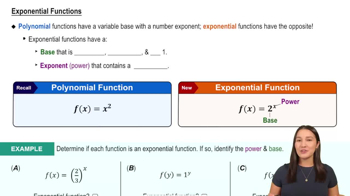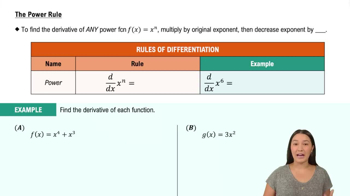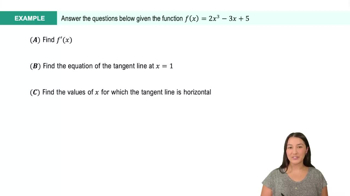Table of contents
- 0. Functions7h 52m
- Introduction to Functions16m
- Piecewise Functions10m
- Properties of Functions9m
- Common Functions1h 8m
- Transformations5m
- Combining Functions27m
- Exponent rules32m
- Exponential Functions28m
- Logarithmic Functions24m
- Properties of Logarithms34m
- Exponential & Logarithmic Equations35m
- Introduction to Trigonometric Functions38m
- Graphs of Trigonometric Functions44m
- Trigonometric Identities47m
- Inverse Trigonometric Functions48m
- 1. Limits and Continuity2h 2m
- 2. Intro to Derivatives1h 33m
- 3. Techniques of Differentiation3h 18m
- 4. Applications of Derivatives2h 38m
- 5. Graphical Applications of Derivatives6h 2m
- 6. Derivatives of Inverse, Exponential, & Logarithmic Functions2h 37m
- 7. Antiderivatives & Indefinite Integrals1h 26m
- 8. Definite Integrals4h 44m
- 9. Graphical Applications of Integrals2h 27m
- 10. Physics Applications of Integrals 2h 22m
3. Techniques of Differentiation
Basic Rules of Differentiation
Problem 3.9.13
Textbook Question
Find d/dx (In(xe^x)) without using the Chain Rule and the Product Rule.
 Verified step by step guidance
Verified step by step guidance1
Step 1: Begin by recognizing that the expression inside the logarithm is a product: \(xe^x\). We can use the property of logarithms that \(\ln(a \cdot b) = \ln(a) + \ln(b)\). Apply this property to rewrite the expression as \(\ln(x) + \ln(e^x)\).
Step 2: Simplify \(\ln(e^x)\). Recall that \(\ln(e^x) = x \cdot \ln(e)\), and since \(\ln(e) = 1\), this simplifies to \(x\). Therefore, the expression becomes \(\ln(x) + x\).
Step 3: Differentiate \(\ln(x)\) with respect to \(x\). The derivative of \(\ln(x)\) is \(\frac{1}{x}\).
Step 4: Differentiate \(x\) with respect to \(x\). The derivative of \(x\) is simply \(1\).
Step 5: Combine the derivatives from Step 3 and Step 4. The derivative of \(\ln(x) + x\) is \(\frac{1}{x} + 1\).
 Verified video answer for a similar problem:
Verified video answer for a similar problem:This video solution was recommended by our tutors as helpful for the problem above
Video duration:
4mPlay a video:
Was this helpful?
Key Concepts
Here are the essential concepts you must grasp in order to answer the question correctly.
Natural Logarithm Properties
Understanding the properties of natural logarithms is essential for simplifying expressions involving ln. Specifically, the property ln(a*b) = ln(a) + ln(b) allows us to break down the logarithm of a product into a sum, which can simplify differentiation.
Recommended video:

Change of Base Property
Exponential Functions
Exponential functions, such as e^x, have unique properties that make them easier to differentiate. The derivative of e^x is e^x itself, which simplifies calculations significantly when combined with logarithmic functions.
Recommended video:

Exponential Functions
Basic Differentiation Rules
Familiarity with basic differentiation rules, such as the derivative of a constant and the power rule, is crucial. These rules provide the foundation for finding derivatives without relying on more complex techniques like the Chain Rule or Product Rule.
Recommended video:

The Power Rule

 3:59m
3:59mWatch next
Master Derivatives of Linear Functions with a bite sized video explanation from Callie
Start learningRelated Videos
Related Practice






